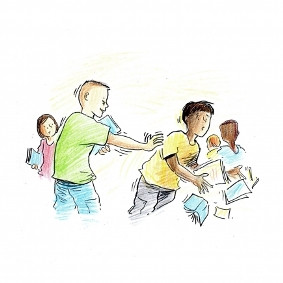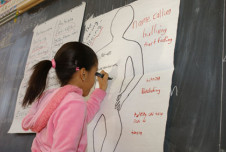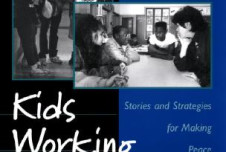Bullying in schools is now widely recognized as a serious social problem that must be addressed if we care about the well-being of bullied children. Thus far, however, attempts to reduce bullying in schools have largely failed.
A 2004 comprehensive evaluation of the effectiveness of anti-bullying programs in schools around the world (Bullying in Schools: How Successful Can Interventions Be? edited by Peter K. Smith, Debra Pepler, and Ken Rigby) found that achievements so far have been modest at best. In some cases, the interventions have been totally unsuccessful. Why have anti-bullying programs met with so little success? We suggest two important reasons.
 Examples of physical and verbal bullying depicted in the authors' video
Examples of physical and verbal bullying depicted in the authors' video
The first is that educators have concentrated on encouraging teachers and counselors to watch what is happening and take strong disciplinary action when bullying has occurred. Unfortunately, school authorities are commonly unaware of what is going on. This is not to blame them. It is simply to recognize that bullying goes on in the company of peers and rarely in the company of teachers. Children see it happening, but the teachers do not. Only occasionally do students tell.
The second reason why anti-bullying programs often fail is because they are not effectively supported by children. One of the startling facts to emerge from the research into children’s behavior in recent years has been the almost ubiquitous presence of other children when bullying takes place in schools. We can no longer conceive of bullying at school as a covert activity, engaged in guiltily when there is no one around. On the contrary, research has found that school bullies glory in the presence of an audience. It provides theater. To a remarkable extent, the watchers either enjoy the spectacle or watch in a curious but largely disengaged manner. The few who may object are in a small minority.
Yet some do object. And here is another remarkable fact. On those rare occasions when a witness does object to bullying, there is a good chance that the bullying will stop. Indeed, several researchers have reported that bystander objections effectively discourage bullying at least half the time.
Educators are now beginning to think that promoting positive bystander intervention may be a more effective way to counter bullying. To succeed, anti-bullying programs must enlist the support of children. But, as we have noted, children typically just stand by and watch bullying take place. Why don’t they act? More to the point, how can they be encouraged to act and to act effectively? We need to know what students typically do when they’re bystanders in the presence of bullying, and why.
In our own research, we set out to cast some light on children’s motives by showing them a video of different kinds of bullying, then asking them what they would do in each situation. We found that while a small proportion would support the bullying and many would ignore it, a substantial number of children believed they would act to support the victim. Their good intentions—which ranged from simple moral justifications to the desire for reciprocal benefit to feelings of empathy or close identification with the victim—can be encouraged and leveraged to help stop bullying.
We now have useful insights into what children think and are prepared to do when they witness bullying in the school playground. This knowledge can help us to devise more effective ways of addressing the problem, such as catalyzing classroom discussions about bullying and rehearsing with students what they might say when they see bullying take place. In these ways, we might influence bystanders to act more positively in the face of bullying.
The young bystander
To find out what children think when they witness bullying, we made a video of cartoons showing different kinds of bullying—both physical and verbal—with bystanders present. (See figures) We showed the video to school children in upper elementary and lower high school classes in South Australia. As part of what we called the International Bystander Project, colleagues showed the same video to similar groups of school children in England and South Africa, and, with appropriate translations, to children in Italy, Israel, and Bangladesh.
When asked what they would personally do as a bystander in each situation, children in the different countries responded in much the same way. Most of the children were divided between those who believed they would act in some way to support the victim and those who would ignore him.
The reasons given for not helping the victim fell into four categories.
The first was that it was “not my concern.” Some children wrote: “It is not my problem if someone I don’t know is getting picked on”; “It isn’t nice to intrude on someone’s business”; “I am just an onlooker”; “They can solve it all by themselves”; and “None of my business.”
A second reason was fear of the consequences: “The people may turn on ME!”; “If I got involved I would probably get bashed”; “I would be scared it would happen to me”; “It might be embarrassing”; and “I don’t want to be a ‘sissy’ by telling a teacher.”
Thirdly, some felt that the responsibility is (or should be) with the victim. “He [the victim] should stick up for himself.” “Most people can take care of themselves and sometimes the [victims] deserve it.” Older children were more likely to feel unsympathetic toward victims and blame them for being victimized.
Fourthly, some argued that personal action to stop the bullying would be useless, or might even make matters worse. “They would not take any notice of me,” wrote one child. “If I ignored it, it might stop, because they are not getting any attention,” wrote another.
Sadly, some children—and some adults too—approve of bullying. Some find the violence or the possibility of violence attractive. “I love to watch fights.” “Every kid likes to have fun and I am part of it.” In some cases there is sincere admiration for the bullies. “The person insulting the other person is cool and ROCKS.” Several seemed to have genuinely sadistic motives: “The person pushing [the victim] is me or my friend and you gotta be cruel.” “Some people deserve to get their heads kicked in because they are dickheads.” Some believed that supporting the bully was the safer option: “Everyone would be on the insulter’s side so I’m not going on the insulted side because I would get drilled.”
Fortunately, children with these attitudes are in the minority.
Behind the good intentions
Some children believed they would try to support the victim. We learned from the children what lay behind their good intentions. In many cases, children gave a simple moral explanation. They said that bullying was simply “wrong,” so then acting to stop the bullying was “right.” These children wrote: “It feels like the right thing to do”; “It is wrong to harass someone like that”; “It is not right to bully.”
Some gave no morally explicit justification. They saw themselves as helping victims because it was their basic nature to do so, expressed in such statements as these: “I am not a mean person”; “I always like to help others”; and “I don’t know why, I just would.”
The responses of some students were related to empathic feelings, such as concern or pity, which they had toward victims: “I feel sorry for them and do not want them to get hurt;” “I don’t like seeing people’s feelings being hurt”; “They [victims] are usually the ones who can’t stand up for themselves;” “They need support—they may be scared”; “I can imagine how the person [the victim] would feel.”
Some closely identified with the victim. These children’s intentions appear to be strongly related to their own feelings about having been bullied, or their sense that they would appreciate being helped if they were bullied. “If I got pushed over I wouldn’t like it.” “I have been in similar situations and I know what it feels like to be bullied.” “It has happened to me before and no one stuck up for me and that made me feel angry.” “I don’t want other people to go through what I went through in Year 3.” “If it was me, I would like somebody to help me.”
Another group was looking for a reciprocal benefit. “If I helped someone they might help me,” wrote one child. “It is nice to help and I would probably make a new friend if I did,” wrote another.
For a few, helping the victim was conditional: “I would support friends if they were being insulted but if I didn’t know them I would ignore it. If he was my friend I would stick up for him.”
Finally, several students saw the possibility of gaining higher status through a heroic gesture. “I could become a hero!” wrote a child.
Despite the good intentions expressed by children in our study, previous studies have found that not nearly as many children actually support bullying victims in real life. It seems that in the actual situation, the good intentions would not always be carried out. In addition, our finding that high-school children were more prepared to ignore what was going on is consistent with earlier research findings indicating that in the early teenage years, children become increasingly unsympathetic to victims of bullying and more likely to blame them for not standing up for themselves.
There is clearly no monolithic pattern to how children think they should act when they witness bullying behavior. As our analyses show, there is a wide spectrum of attitudes and beliefs underlying different behavioral intentions. And no doubt many children are conflicted about what they should or should not do. Such children are highly susceptible to influence from others.
We are apt to speak knowingly of a child’s “peer group,” as if we know what “it” thought and what its influences are. If so, we are wrong. In our study, children were asked to say what they thought their friends expected them to do when they saw somebody being bullied at school. Some indicated that they felt that their friends would expect them to do nothing; a few thought that their friends would expect them to join in the bullying! A substantial proportion felt that their friends expected them to help the victim. It became obvious that it is more accurate to speak of “peer groups” rather than “the” peer group, with its largely negative connotation.
We took another step. This time we correlated judgments of what children thought their friends expected them to do as bystanders witnessing bullying with what they themselves said they would do. Result: Those who expressed an intention to help the victim were in most cases the ones who thought their friends expected them to do so. Of course, these pro-active students may have been deluded, but we think not. Children by and large know what their friends are thinking.
Adult influence
But what about adults? What influence can they have?
We asked the children what they thought their mothers, fathers, and teachers expected of them when they witnessed bullying behavior at school. On the whole, the children said they thought these adults expected them to help the victim, though there were some variations in what exactly the children believed was expected of them.
Importantly, these variations did not correlate with what the children indicated they were actually prepared to do. For instance, children who thought their parents expected them to help the victim were no more likely to say that they would do so than other children. Apparently, neither mothers nor fathers nor teachers were having any significant impact on the children’s bystander behavior. This supports what many social psychologists and some developmental psychologists have told us. By the time children are in upper primary school, parental and teacher influence on their children’s peer-related behavior is practically nonexistent.
This last finding must be painful to parents who want to believe that they can guide their children in the right way to behave. It is disconcerting to teachers who like to think that if they earnestly continue to tell children how they should treat each other—“With respect, please!”—that they will succeed. This is not to say that parents and teachers can never help children learn to cooperate and feel empathic toward others. Of course, many do. But our finding does suggest the limits of merely telling children how we adults expect them to behave with peers.
What educators can do
Once we recognize that the most effective influence on children’s bystander behavior is what they think their friends expect of them (not what their teacher or parents think), we can begin to devise ways in which positive peer influence can make itself felt.
What teachers can do must be indirect. It must also seek to leverage the widespread good intentions that we have documented, so that children can be encouraged to object to bullying when the teacher is not around. We reason that once children know how many of their peers feel about bullying and why they think it should be stopped, there is a good chance that some of them—especially those “on the fence”—will be influenced by what they have learned.
Our suggestion is this. Begin by showing children pictures or videos of bystanders witnessing bullying, and pose the question of what they, as bystanders, would do about it. Then ask them to give their reasons for their choice of action. Some teachers may prefer to have the children write down their answers. Our findings suggest that many of the children will make statements that carry considerable moral influence. A skillful teacher can ensure that these statements are heard.
At the same time, it would be foolish to ignore the misgivings that some children will have about intervening in potentially risky situations. We have found that some of the most hesitant children are ones who have been bullied in the past. Teachers must acknowledge that there can be grounds for caution. It is sensible to identify and discuss situations that may be dangerous, and explain that it may sometimes be wise to get outside help for the person who is being bullied—for instance, by informing a teacher.
Teachers can consider ways in which the risk of intervening can be minimized. For example, children can state their disapproval of what is going on rather than getting physically involved in any fighting. And especially, they can encourage their friends to speak up and voice their opposition to the bullying. Students may rehearse what they might say when they witness bullying and—if appropriate for the group—they may even take part in role playing exercises that simulate bystander situations.
For a bystander program to make an impact, educators must persist with it. A one-off session with a class is not likely to be effective. We strongly recommend that students be asked to report back to the class on their experiences, good and bad, after they have acted to discourage bullying. In this way the teacher, as well as the children, learn about what can be done to translate good intentions into effective action.
Promoting bystander intervention is not risk free. The impetuous will make mistakes. Enemies may be made as well as friends. Being a hero can be close to feeling a fool. By being thoughtful and learning from experience, one can minimize the risk, but never eliminate it. Yet what is the alternative? Edmund Burke identified it: “All that is necessary for the triumph of evil is for good men to do nothing.”




Comments